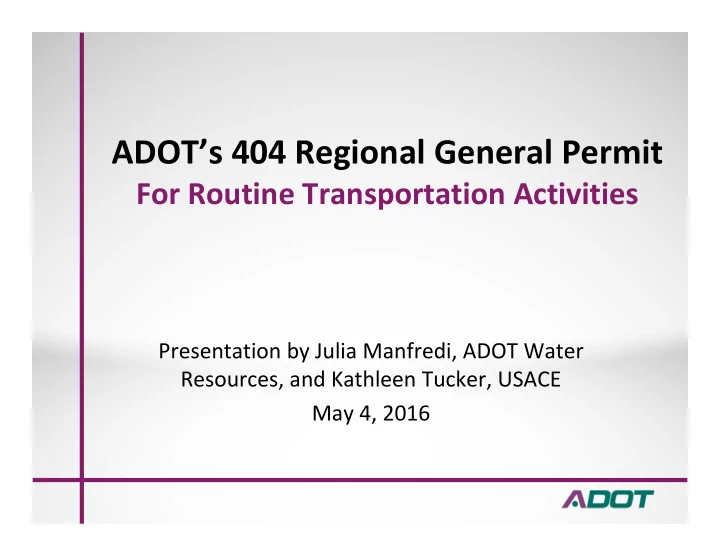

ADOT’s 404 Regional General Permit For Routine Transportation Activities Presentation by Julia Manfredi, ADOT Water Resources, and Kathleen Tucker, USACE May 4, 2016
Why A Regional General Permit? Permit specific to typical ADOT activities Reduce paperwork and processing times Reduce delays to conduct work
Where Does the Permit Apply? Non ‐ tribal lands in AZ only ADOT right ‐ of ‐ way and easements (including TCEs) Local public agency projects with federal funding, bid and administered by ADOT
When is the RGP Not Appropriate? When a Nationwide Permit is more appropriate for the activity When the RGP thresholds are exceeded, requiring an individual permit instead When the project is being evaluated under an Environmental Impact Statement for NEPA
Authorized Activities Structure maintenance Geotechnical activities Sediment and debris and removal Erosion repair Emergency activities Re ‐ establishing design flow Bed stabilization Bank stabilization Routine linear transportation projects
Notification Thresholds Non ‐ notification Concurrence Notification Pre ‐ Construction Notification Depends on activity and/or impact threshold. Impact thresholds are greater than what is typical under the Nationwide Permits.
Non ‐ Notification Official PJD not needed. Provide documentation to file. No permit wait time at the Corps. No work in perennial waters or wetlands. Non ‐ notification not allowed where the project has the potential to affect threatened or endangered species or historic properties. Use Concurrence Notification instead.
Tracking Requirements for Non ‐ notification Construction and maintenance projects working under non ‐ notification must be tracked. Information in the construction project file must include: Activity description Start and end dates of the work in Waters Project coordinates Restoration/revegetation activities/date installed Before and after photos Discussion of any problems and corrections
Concurrence Notification Abbreviated PJD submittal needed, can be submitted at the same time as the Concurrence Notification Form. Include PJD form, USGS quadrangle, map showing OHWM and upstream and downstream coordinates Permit wait time at the Corps = 14 days Presume concurrence if no response from the Corps after 14 days.
Concurrence Notification Allows impact to perennial waters (up to 0.1 acre), but not wetlands If the activity may affect threatened or endangered species, or historic properties, Corps will not permit the project until USFWS, SHPO/THPO documentation is received.
RGP 96 Concurrence Notification Form
Full Pre ‐ Construction Notification Full PJD needed. Per previous ADOT guidance. Permit wait time at the Corps is per MOA. 15 days for Corps to let ADOT know if application is complete 45 days to issue verification when application is complete
Full Pre ‐ Construction Notification Allows impacts to perennial waters (over 0.1 acre) and wetlands (up to 0.025 acre) If the activity may affect threatened or endangered species, or historic properties, Corps will not permit the project until USFWS, SHPO/THPO documentation is received.
Notification Submittals Concurrence: Concurrence form, “abbreviated” PJD (submitted concurrently), documentation for compliance with ESA and Section 106 Additional description needed for bank stabilization projects PCN – same as before under Nationwide Permits Submit PJD separately ahead of the PCN
RGP 96 Concurrence Notification Form
Environmental Planning Technical Guidance Webpage Look for all updated information and RGP resources on the website next week.
General Conditions and Administration Similar to the conditions we typically see in 404 permits Detailed conditions for compliance with Section 106 and discovery of human remains (same as typical) Permits cannot be combined Comply with the 401 Water Quality Certification Provide a copy to field staff, contractors, subs, equipment operators. Have a copy on site.
Resource Protection Prior to submittal of a PCN under the RGP, use the AZ Game and Fish online environmental tool. Typical coordination with AZGFD applies. Follow ESA and MBTA, provide documentation to the Corps Flag work area Maintain downstream flows, do not divert flows outside of the OHWM, minimize flooding No materials harmful to fish or wildlife should be placed within the OHWM
Site Restoration Invasive and noxious weeds removed as part of the project should be disposed of off ‐ site and per state and federal laws and executive orders. Corps will require compensatory mitigation, if deemed appropriate
Restrictions on Discharge Show staging and storage in the plans. Staging and storage should be 100 feet from waters. Less than 100 feet depends on Corps approval. Use best management practices (control measures) according to ADOT Erosion and Pollution Control Manual Perform work when channel is dry or flows are minimal
401 Water Quality Certification of RGP Individual certification specific to RGP Authorizes only the activities in the RGP Broken down by non ‐ notification and pre ‐ project notification If we notify the Corps (Concurrence or PCN), we notify ADEQ Provide 14 days notice. Use 401 certification form. Certification shall be provided to contractors and a copy on site Typical 401 certification conditions
RGP Use Near Impaired or Outstanding Waters
RGP Use Near Impaired or Outstanding Waters
In Summary The RGP Adds a tiered approach to notification Reduces paperwork Authorizes minor impacts to wetlands, permanent impacts to ephemeral washes over 0.5 acre, and increases the linear footage threshold for bank protection Reduces delays Makes compliance easier
QUESTIONS? Julia Manfredi ADOT Water Resources Jmanfredi@azdot.gov 602 ‐ 712 ‐ 7947
Recommend
More recommend